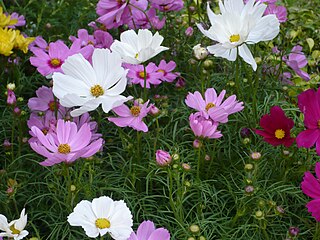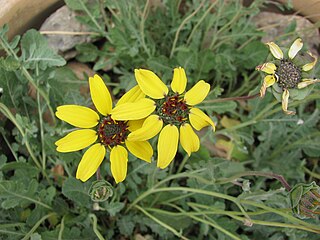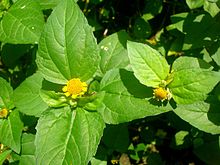
Cosmos is a genus, with the same common name of cosmos, consisting of flowering plants in the sunflower family.

Tagetes is a genus of annual or perennial, mostly herbaceous plants in the family Asteraceae. They are among several groups of plants known in English as marigolds. The genus Tagetes was described by Carl Linnaeus in 1753.

Tanacetum is a genus of about 160 species of flowering plants in the aster family, Asteraceae, native to many regions of the Northern Hemisphere. They are known commonly as tansies. The name tansy can refer specifically to Tanacetum vulgare, which may be called the common tansy or garden tansy for clarity.

Conyza is a genus of flowering plants in the family Asteraceae.

Gerbera L. is a genus of plants in the Asteraceae (Compositae) family. The first scientific description of a Gerbera was made by J. D. Hooker in Curtis's Botanical Magazine in 1889 when he described Gerbera jamesonii, a South African species also known as Transvaal daisy or Barberton daisy. Gerbera is also commonly known as the African daisy.

Leucanthemum is a genus of flowering plants in the aster family, Asteraceae. It is mainly distributed in southern and central Europe. Some species are known on other continents as introduced species, and some are cultivated as ornamental plants. The name Leucanthemum derives from the Greek words λευκός – leukos ("white") and ἄνθεμον – anthemon ("flower"). Common names for Leucanthemum species usually include the name daisy, but "daisy" can also refer to numerous other genera in the Asteraceae family.

Spilanthes is a genus of African and South American plants in the tribe Heliantheae within the family Asteraceae.

Calendula officinalis, the pot marigold, common marigold, ruddles, Mary's gold or Scotch marigold, is a flowering plant in the daisy family Asteraceae. It is probably native to southern Europe, though its long history of cultivation makes its precise origin unknown, and it may possibly be of garden origin. It is also widely naturalised farther north in Europe and elsewhere in warm temperate regions of the world.

Astereae is a tribe of plants in the family Asteraceae that includes annuals, biennials, perennials, subshrubs, shrubs, and trees. Plants within the tribe are present nearly worldwide divided into 170 genera and more than 2,800 species, making it the second-largest tribe in the family behind Senecioneae. They are found primarily in temperate regions of the world.

Lopholaena is a genus of perennial shrubs and herbaceous plants in the family Asteraceae. About 20 species occur from tropical to southern Africa.

Pluchea is a genus of flowering plants in the tribe Inuleae within the family Asteraceae. Members of this genus might be known as camphorweeds, plucheas, or less uniquely fleabanes. Some, such as P. carolinensis and P. odorata, are called sourbushes. There are plants of many forms, from annual and perennial herbs to shrubs and trees, and there is variation in the morphology of leaves, flowers, and fruits.

Berlandiera is a genus of flowering plants in the family Asteraceae.

Grindelia hirsutula is a North American species of flowering plant in the family Asteraceae known by the common names hairy gumplant and hairy gumweed.

Barkleyanthus is a monotypic genus of flowering plants in the aster family, Asteraceae, containing the single species Barkleyanthus salicifolius, a plant formerly classified in the genus Senecio. It is native to North and Central America, where its distribution extends from the southwestern United States to El Salvador. Its common names include willow ragwort, willow groundsel, Barkley's-ragwort, and jarilla.

Blainvillea is a genus of flowering plants in the family Asteraceae. They are native to tropical and subtropical regions of Africa, Australia, and Latin America.

Acmella oleracea is a species of flowering herb in the family Asteraceae. Common names include toothache plant, Szechuan buttons, paracress, buzz buttons, tingflowers and electric daisy. Its native distribution is unclear, but it is likely derived from a Brazilian Acmella species. It is grown as an ornamental and attracts fireflies when in bloom. It is used as a medicinal remedy in various parts of the world. A small, erect plant, it grows quickly and bears gold and red inflorescences. It is frost-sensitive but perennial in warmer climates.

Borrichia frutescens is a North American species of flowering plants in the family Asteraceae known by the common names sea oxeye, sea oxeye daisy, bushy seaside tansy, and sea-marigold. In Veracruz it is called verdolaga de mar. It is native to the United States and Mexico, where it occurs along the Atlantic and Gulf Coasts. Its distribution extends from Maryland south to Florida and west to Texas in the US, and along the Mexican Gulf Coast to the Yucatán Peninsula. It is an introduced species in some areas, such as Bermuda and Spain.

Acmella uliginosa, the marsh para cress, is a species of flowering herb in the family Asteraceae. The plant is native to South America and is naturalized in parts of Asia and Africa.

Acmella repens is a North American species of flowering plants in the family Asteraceae. The plant is native to the southeastern and south-central United States, primarily in the coastal plain from Texas to North Carolina and in the lower Mississippi Valley from Missouri to Louisiana. There are additional populations in Coahuila in northeastern Mexico.

Felicia is a genus of small shrubs, perennial or annual herbaceous plants, with 85 known species, that is assigned to the daisy family. Like in almost all Asteraceae, the individual flowers are 5-merous, small and clustered in typical heads, and which are surrounded by an involucre of, in this case between two and four whorls of, bracts. In Felicia, the centre of the head is taken by yellow, seldom whitish or blackish blue disc florets, and is almost always surrounded by one single whorl of mostly purple, sometimes blue, pink, white or yellow ligulate florets and rarely ligulate florets are absent. These florets sit on a common base and are not individually subtended by a bract. Most species occur in the Cape Floristic Region, which is most probably the area where the genus originates and had most of its development. Some species can be found in the eastern half of Africa up to Sudan and the south-western Arabian peninsula, while on the west coast species can be found from the Cape to Angola and one species having outposts on the Cameroon-Nigeria border and central Nigeria. Some species of Felicia are cultivated as ornamentals and several hybrids have been developed for that purpose.



















